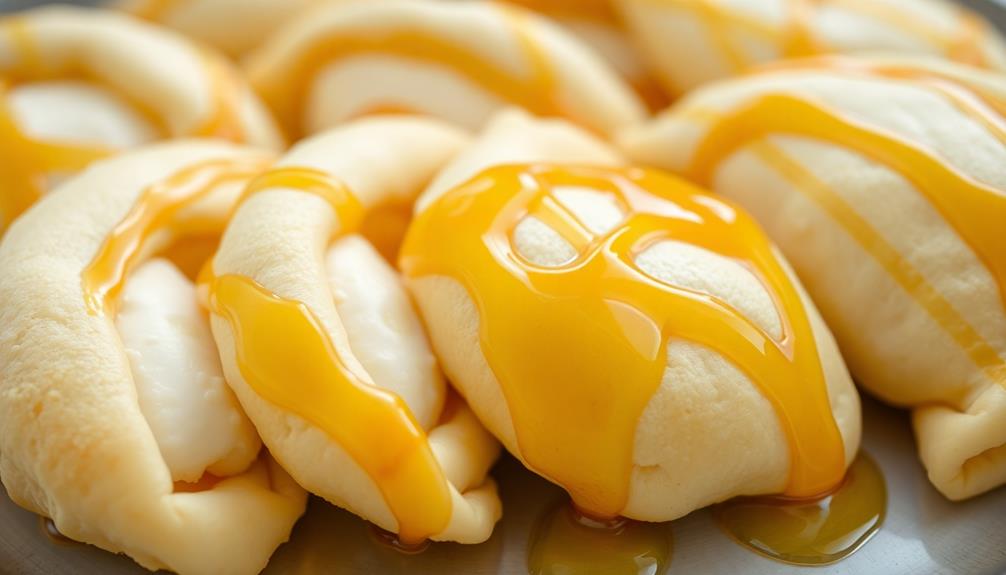To make Lebanese kibbeh at home, start by soaking bulgur until soft, then mix it with minced onions, salt, and spices to form a firm dough. Shape the dough into ovals with hollow centers, fill with seasoned ground meat, onions, and pine nuts, then seal and shape. You can fry or bake them for different textures. If you want to master this delicious dish, keep exploring the step-by-step process and tips for perfect results.
Key Takeaways
- Prepare a bulgur wheat dough by soaking, draining, and kneading with minced onions and spices until cohesive.
- Shape the dough into ovals or torpedoes with hollow centers for filling.
- Fill with seasoned ground meat mixture, including onions, pine nuts, and spices like cinnamon and allspice.
- Seal the openings and shape the kibbeh before cooking.
- Fry or bake until golden and crispy, adjusting for desired texture and flavor.

Have you ever tasted Lebanese kibbeh? If not, you’re in for a delicious experience. This iconic dish is a staple in Lebanese cuisine, loved for its savory filling and crispy exterior. Making kibbeh at home allows you to enjoy its rich flavors and customize it to your taste. To start, understanding its traditional preparation is key. Classic Lebanese kibbeh involves a fine bulgur wheat crust filled with a seasoned mixture of ground meat, onions, and spices. The process begins by soaking the bulgur in cold water until it softens, then draining it thoroughly. You’ll blend it with minced onions and a pinch of salt, kneading everything together until it forms a cohesive dough. The traditional preparation emphasizes maintaining the right texture—firm yet pliable—so the kibbeh holds its shape during cooking. Once the dough is ready, you shape it into ovals or torpedoes, creating a hollow cavity to stuff with the meat mixture. The filling combines ground lamb or beef, finely chopped onions, pine nuts, and a blend of spices like cinnamon, allspice, and nutmeg. After stuffing, you seal the openings and shape the kibbeh into either oval or round forms, depending on your preference. Baking or frying are common methods for cooking, with frying giving it a crispy outer shell and baking offering a healthier alternative. Modern techniques also incorporate noise reduction technology in appliances to ensure quieter cooking experiences, which can be beneficial during the preparation process.
Regional variations add a layer of diversity to this dish. In northern Lebanon, you’ll find kibbeh with a more pronounced use of fresh herbs and sometimes a hint of garlic. The southern regions often incorporate more spices, creating a spicier version, while coastal areas might include seafood or different types of nuts. These regional variations reflect local ingredients and culinary traditions, making each version uniquely flavorful. If you’re experimenting at home, feel free to adapt the filling with regional ingredients or spices that suit your taste. The versatility of kibbeh allows for endless customization, whether you prefer it baked, fried, raw (as in kibbeh nayeh), or cooked in a stew.
Making Lebanese kibbeh at home is a rewarding experience that connects you to centuries of culinary tradition. Pay close attention to the traditional preparation, but don’t be afraid to explore regional variations to create your own signature version. With practice, you’ll master the technique and be able to serve up this delicious dish anytime. Whether you stick to the classic recipe or add your personal twist, homemade kibbeh promises a hearty, flavorful meal that captures the essence of Lebanese cuisine.
Frequently Asked Questions
Can I Freeze Lebanese Kibbeh for Later Use?
Yes, you can freeze Lebanese kibbeh for later use. To guarantee quality, follow proper freezing tips: let the kibbeh cool completely, then wrap it tightly in plastic wrap or place it in an airtight container. Label it with the date, and store it in the freezer for up to 3 months. When ready to enjoy, reheat thoroughly for the best taste and texture.
What Are Traditional Side Dishes Served With Kibbeh?
You should serve kibbeh with traditional accompaniments like fresh tabbouleh, creamy hummus, and tangy yogurt sauce. For serving suggestions, add a side of pickled vegetables or a simple fattoush salad to balance flavors. These traditional accompaniments enhance the dish’s richness and provide a invigorating contrast. Incorporating these elements makes your meal more authentic and satisfying, giving you a well-rounded Lebanese dining experience.
Is It Possible to Make Vegan or Vegetarian Kibbeh?
Yes, you can make vegan or vegetarian kibbeh by using plant-based alternatives. Swap out meat with ingredients like lentils, mushrooms, or walnuts for a hearty texture. You can also experiment with flavor variations by adding spices, herbs, or even roasted vegetables. This way, you keep the traditional taste while making it suitable for vegans and vegetarians. It’s a delicious, adaptable dish that suits various dietary preferences.
How Long Does Homemade Kibbeh Stay Fresh?
Imagine opening your fridge to find your homemade kibbeh still smelling fresh and tempting. Typically, kibbeh stays good for about 2-3 days when stored properly in an airtight container. Use proper kibbeh storage and freshness tips by keeping it refrigerated and avoiding exposure to air. For longer freshness, consider freezing it; just reheat thoroughly before enjoying. This way, your homemade kibbeh remains delicious and safe to eat.
Can I Use Gluten-Free Ingredients for Kibbeh?
Yes, you can use gluten-free alternatives and grain substitutions for kibbeh. To keep the traditional texture and flavor, try using gluten-free bulgur or quinoa as your base. You might also consider almond or chickpea flour for binding. Keep in mind that these substitutions may slightly alter the taste and consistency, but they offer a delicious gluten-free option for enjoying kibbeh without gluten.
Conclusion
Now that you know how to make Lebanese kibbeh at home, you can enjoy its rich flavors and crispy texture anytime. You can customize the filling, perfect the crust, and serve it fresh or reheated, making each bite uniquely yours. By mastering this traditional dish, you embrace a taste of Lebanon, a symbol of hospitality, heritage, and love. So, gather your ingredients, follow these steps, and delight in creating a meal that’s both authentic and unforgettable.










